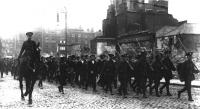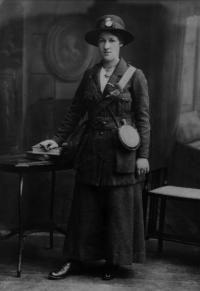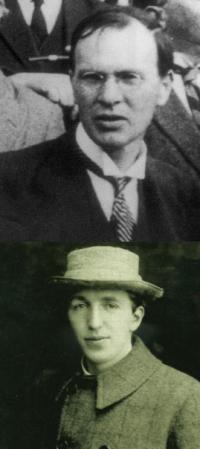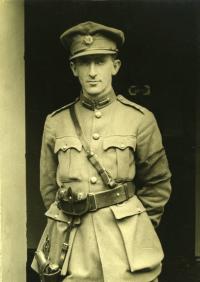‘Too many histories’? The Bureau of Military History and Easter 1916
Published in 20th-century / Contemporary History, Devalera & Fianna Fail, Features, General, Issue 6 (Nov/Dec 2011), Revolutionary Period 1912-23, Volume 19
Rank-and-file rebel prisoners being led away after the Rising. The Bureau of Military History statements provide revealing insights into their mentality. (RTÉ Stills Library)

Cumann na mBan member Rose McNamara, who served in Marrowbone Lane distillery—one of c. 200 women who took part in the Rising. Women, comprising less than 10% of the interviewees, were underrepresented, reflecting contemporary assumptions about the relative importance of their contribution. (National Museum of Ireland)
1,773 statements, 36,000 pages
By 1959 the Bureau had recorded 1,773 statements, mainly by members of the Irish Volunteers, the Irish Republican Brotherhood, Sinn Féin, the Irish Citizen Army and Cumann na mBan. Although varying widely in terms of accuracy, detail and interest, its 36,000 pages of evidence form one of the richest oral history archives devoted to any modern revolution. This can only have added to the dismay of the historians who cooperated with the Bureau when this remarkable archive was sealed within 83 steel boxes in the strongroom of Government Buildings, where it remained unavailable for public or scholarly scrutiny until its release in 2003, following the death of the last witness.Such a source inevitably raises a host of problematic issues, both ideological and practical: these include the subjectivity of oral history, the role of the state in the creation of a project intended to record and shape historical memory, the selective nature of the testimony collected, the reliability of the witnesses’ memories, the influence of subsequent events and knowledge, and the potential for bias, not least as a result of the Civil War.
Variations of style, content and plausibility
The statements certainly vary widely in terms of style, content and plausibility. Some are egocentric, self-serving or otherwise unconvincing in tone. Others seek to shift blame, justify actions or settle scores. Some recall events or conversations in implausible detail. A few are literary constructs, fashioned from previously published accounts. Politicians, inevitably, have bequeathed some of the most interesting but slippery accounts: figures such as Ernest Blythe and Bulmer Hobson were not so much recording their recollections of the past as making appeals to posterity. The vast bulk of the Bureau’s statements, however, are measured accounts that convey an air of authenticity. They record the testimony of relatively unknown veterans who believed in the importance of recording the minor role they played in an event that they regarded as the most important of their lives. They make no great claims as to the wider significance of their actions and are characterised by modesty rather than vanity or self-interest. A few record doubts and regrets about past actions.

Figures such as Ernest Blythe (above) and Bulmer Hobson (below) were not so much recording their recollections of the past as making appeals to posterity. (George Morrison, Marnie Hay)
Imperfect and partial recollections
Like any historical source, however, they must be evaluated carefully. They record not the events of the revolution but the witnesses’ imperfect recollections of them from a remove of several decades. Dates, numbers and other details are often inaccurate, and some claims seem less plausible than others. Did Father Flanagan of Ringsend invent the sawn-off shotgun? Did the provisional government’s members, as Desmond Ryan claimed, really spend the first night of the Republic under the influence of opium?They are also a partial record: the Bureau’s investigators chose who to interview and who not to interview. Women, comprising less than 10% of the interviewees, were underrepresented, reflecting contemporary assumptions about the relative importance of their contribution. Few constitutional nationalists, unionists, members of the Crown forces or British officials were invited to submit statements, while some of those who were declined to do so. Alfred Cope, a former assistant under-secretary in Dublin Castle, refused on the grounds that ‘it is not possible for this history to be truthful’:
‘The IRA must be shown as national heroes and the British forces as brutal oppressors . . . What a travesty it will be and must be. Read by future generations of Irish children, it will simply perpetuate the long-standing hatred of England and continue the miserable work of self-seeking politicians . . . Ireland has too many histories: she deserves a rest.’
Many refusals
Some veterans, unwilling to betray confidences or simply wishing to forget the past, also refused to record statements; one flying column member explained that his memories were tainted ‘with a feeling of aversion and self-disgust’. Even among those who felt no such ambivalence an unwillingness to discuss their role in the conflict—even with close family members—was common.Prominent among those who declined to participate were several politicians: Éamon de Valera, the leader of the government that established the Bureau and the most eminent surviving rebel, failed to record a statement, as did veteran of the battle of Ashbourne and former IRA chief-of-staff Richard Mulcahy. The reasons for their reticence are unknown, but a lack of interest in the past—or indifference as to how knowledge of that past was constructed and shaped—were not among them. W.T. Cosgrave’s willingness to submit a statement presents an obvious contrast, but to what extent was his decision to record a statement, one that criticised the military rationale behind the Rising in which he participated ‘as little short of madness’, influenced by his experiences of the destructive legacy of republican zealotry after 1921? Others refused because of their distrust of the project or their antipathy to the state. Elizabeth Farrell, best known for conveying Pearse’s offer of surrender to Brigadier General Lowe, declined on the grounds that ‘all governments since 1921 had betrayed the Republic’. The Civil War, as Farrell’s comments suggest, cast a long shadow: a Bureau official recorded how one veteran had refused their request by sarcastically observing that they should have secured a statement from a former comrade ‘before we shot him’. Pauline Keating, who did submit a statement, was surprised by the attitude of her former Cumann na mBan comrades: ‘they would rather burn anything they had than give it to the Bureau . . . I suggested that the information might be of interest to future generations, but I did not succeed in convincing them.’
Insights into the mentality of the rank-and-file
Owing to their provenance, the witness statements are a challenging source but, for much the same reason, a particularly important one. As with oral sources generally, much of their value lies in their subjectivity. They provide revealing insights into the mentality of rank-and-file separatists, people from lower middle-class and working-class backgrounds who—in contrast to the revolutionary élite—rarely recorded their thoughts in letters, diaries or memoirs. While their political views are often biased—constitutional nationalists and their supporters, for example, are frequently caricatured as opportunistic, venal or supine—they are nonetheless significant. In seeking to understand how separatists viewed themselves, and how they justified their actions, subjective perceptions are more important than empirical realities.Given that much of the statements’ value lies in the insights they provide into the day-to-day experiences of ‘ordinary’ revolutionaries, the Bureau’s long-suffering director, Michael McDunphy, deserves praise for resisting pressure to focus its efforts on the leadership: ‘an ordinary volunteer who served in the ranks and then returned to private life may often have a clearer and perhaps much more important story to tell than one who served with a titular rank’. To their credit, the Bureau’s investigators viewed their task as the collection and preservation of evidence rather than its interpretation. Nor were they blind to the pitfalls of oral history. Detailed instructions were issued in an effort to solicit accurate accounts, and investigators were urged to keep an open mind: ‘Your aim at all times must be to get from him an objective, factual record of events based on his own experiences . . . There must be no attempt to smooth out or adjust a story, in order to make it more plausible or readable.’

Prominent among politicians who declined to participate (including Éamon de Valera, whose government set up the Bureau) was the veteran of the battle of Ashbourne and former IRA chief-of-staff Richard Mulcahy. (Risteárd Mulcahy)
How do they enhance our understanding of the Rising?
Although recorded long afterwards, the statements provide a window into the experiences of separatists during a period when most people regarded republicanism as a hopeless cause advocated by cranks and wreckers. They hint at what it felt like to be there at the time without knowing what would happen next, restoring the all-important element of contingency to history. They demonstrate, for example, how aspects of the Rising presumed to be central to the event were more peripheral for many at the time: the proclamation of the Republic by Pearse, for example, was barely noticed by rank-and-file rebels, and surprised some of those who did take note. The statements convey the chaos of the Rising and highlight the depth of the divisions between the Military Council and those within the IRB and Volunteers who opposed an unprovoked insurrection. The voices of history’s ‘losers’—figures such as Bulmer Hobson, whose reputation was blackened by his efforts to prevent the Rising—can be heard alongside those whose reputations were made (in some cases posthumously) by their decision to fight. The statements provide a wealth of obscure detail, preserving some of the texture of the past rarely recorded by conventional sources: they describe the clothes that people wore (deerstalker hats represented defiance for Sinn Féiners, while evening suits aroused their suspicion), how they moved about (would Enniscorthy have risen or Ashe’s column triumphed at Ashbourne without the bicycle?), and even what they ate (the Oxo cube kept many going during Easter Week, while less fortunate rebels contemplated eating horses). They reveal what rebels knew at the time of the Rising and what they actually did: surprisingly little fighting for the most part, but much praying and the occasional song and dance. They describe the weather during Easter Week: beautiful in Dublin (hastening the decomposition of the corpses and carcasses littering its streets by the end of the week) and atrocious in Cork (compounding the dismal impact of the failed mobilisation).They provide insights into why people joined revolutionary organisations and what they did within them. They describe the obstacles they encountered, whether parental disapproval, clerical censure or the fear of ridicule. There are revealing insights into the social and cultural ethos of Edwardian Ireland. Even within the Citizen Army, for example, women were excluded from an equal role, and differences arising from social status remained significant. The refusal of many women to accept their subordinate status—whether by demanding the right to learn how to shoot, refusing to be kept out of rebel garrisons or insisting on their right to be arrested at the end of Easter Week—is striking.The importance of local factors, familial influences and intergenerational tensions is also evident. The divergence between attitudes in Dublin and provincial Ireland is particularly striking. The accounts of Volunteers from Ulster, Cork, Galway and Limerick suggest that the importance of the Aud’s interception and Eoin MacNeill’s countermanding order has been overestimated as a cause of the failure to rise outside Dublin. Provincial Volunteers differed significantly from the Military Council when it came to their understanding of the purpose, rationale and potential of the Rising, and the Citizen Army’s involvement provoked suspicion throughout rural Ireland. The statements also leave little doubt as to the initial unpopularity of the Rising, while some record in horrific detail its consequences for ordinary Dubliners.Collectively, they challenge the notion of an ideologically coherent rebellion, an impression that owed much to the Rising’s subsequent impact and the visibility of republican iconography such as the Proclamation and tricolour. In describing their own politicisation, many witnesses spoke of fighting for freedom and a hatred of British rule rather than the more sophisticated ideologies articulated by republican leaders. The importance of Catholic nationalism, cultural revivalism and social and communal tensions—whether agrarianism in the west or sectarianism in the north—is more evident than the radical ideals of the Proclamation, and this sheds light on the conservative nature of post-revolutionary Ireland.The statements demonstrate the difficulty of generalising about the divergent beliefs of the rebels or imposing a single narrative on the Rising. They offer a more complex picture of the revolutionary generation: more fractious and flawed than the heroes and martyrs commemorated at the GPO but also more human, vibrant and attractive. By doing so, they may facilitate a more rounded assessment of the rebels and their actions in 2016. HI
Fearghal McGarry lectures in history at Queen’s University, Belfast. His Rebels: voices from the Easter Rising has just been published by Penguin Ireland.
Further reading:
F. McGarry, The Rising. Ireland: Easter 1916 (Oxford, 2010).A. Ryan, Witnesses. Inside the Easter Rising (Dublin, 2005).
















